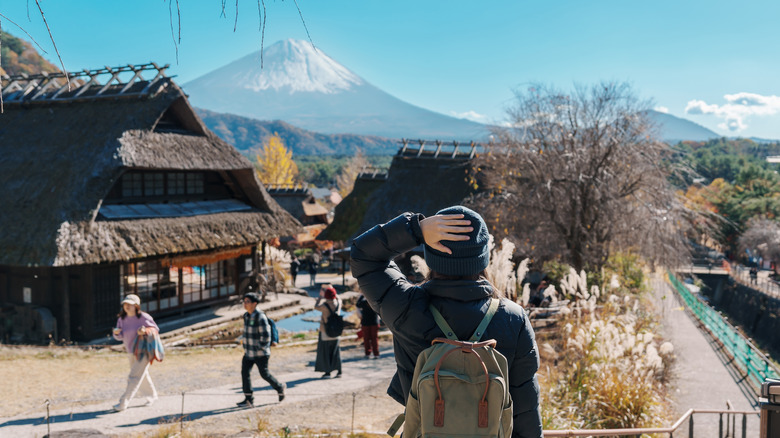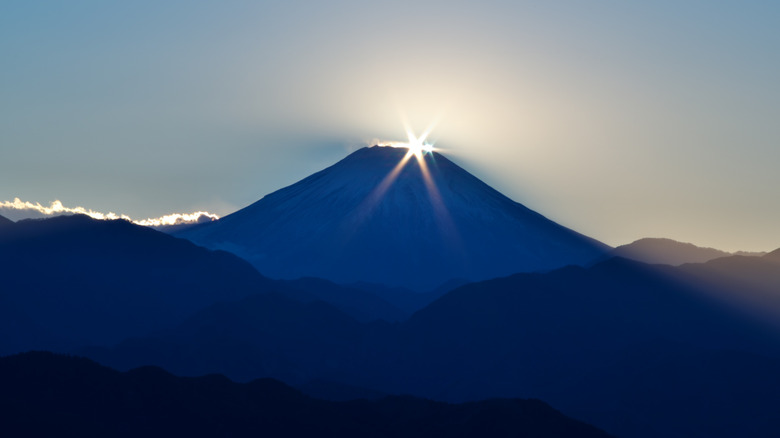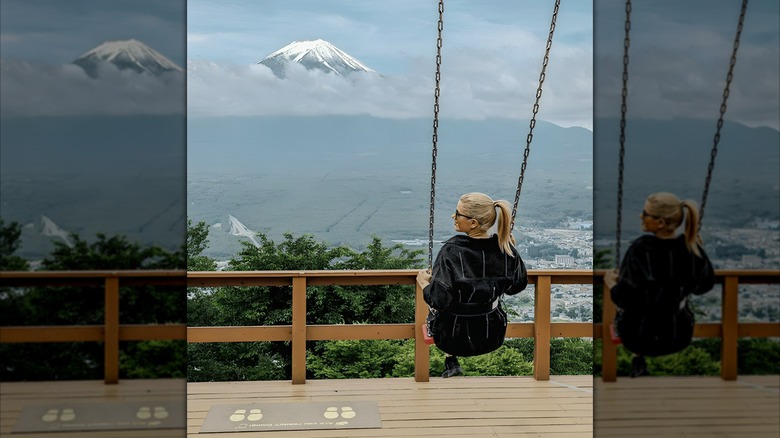The Best Destinations To View Mount Fuji In The Winter
To replicate those postcard-perfect images of Japan's most famous peak, Mount Fuji, you have to visit in the winter months. While the mountain is glorious all year round, the ice-crusted months of November to February add an extra sprinkle of magic to this sacred summit. Drier air in the holiday season means that visitors get a uniquely unobstructed view of Mount Fuji in the winter, with crisp blue skies and almost zero clouds getting in the way.
Winter is also considered the low tourist season in Japan. This means you can explore at your leisure without battling the crowds you would encounter if traveling in the busier seasons of spring and summer. Travelers prefer autumn, too, and many flock to Japan for an ultimate fall foliage getaway.
If slower travel and tranquil scenes are more your speed, then a snow-sprinkled holiday to Fuji-san is a must-have on your travel bucket list. Get your maps and pencils ready because we will explore 12 of the best viewing spots to take in the glory of Mount Fuji in winter. Our selection process involved consulting travel data and zeroing in on sites with panoramic views of the glorious mountain.
Fujiyoshida, Yamanashi prefecture
Looking to experience Mount Fuji alongside a cup of artisanal green tea? The town of Fujiyoshida, located in Yamanashi prefecture, is your best bet for viewing the snow-covered peak while not straying far from the perks of a city. Photographers will rejoice in knowing that Fujiyoshida is home to one of the most iconic shots of Mount Fuji — the one you have most likely spotted on Instagram that shows the peak climbing up into the clear, blue sky adorned with street lamps, powerlines, and shop signs.
This main street, known as Honcho Street, is an important thoroughfare for the city and can be hard to photograph in the busier seasons with cars and pedestrians darting back and forth. However, the winter season is the perfect opportunity to capture this sweet spot free of crowds. With most tourists home for the holidays and locals staying in, Fujiyoshida becomes the playground of the brave few who are unafraid to face the cold for the perfect shot. So why not grab a cup of hot hojicha (Japanese roasted green tea) as you explore this tiny nook of culture at the foot of Fuji-san?
Saiko Iyashi-no-Sato Nemba
Travel back in time with the unique offerings of this former farming village. Just off the banks of Lake Saiko, which is one of the Fuji Five Lakes, this village of thatched-roof cottages is now an open-air museum that welcomes visitors year-round to enjoy traditional Japanese culture alongside the majestic sights of a towering Fuji.
A typhoon disaster in 1966 tragically destroyed most of the buildings in the original Nemba Village. It is now home to 20 heritage houses reconstructed in the traditional kabuto-zukuri style. Today, it operates as a museum that documents a bygone way of life, educating visitors on the lifestyle of farmers and fishermen of centuries past. Souvenir-scouters are in luck, too, as the cottages have been transformed into craft shops that allow visitors to explore local pottery, incense, weaving, and more.
Visit in the winter season for an authentic rural Japanese experience and enjoy these tranquil spots all to yourself. Don't miss the bridge that leads you to the village's entrance, as this offers the most charming view of Mount Fuji alongside the tops of the thatch-roof houses. You just might catch the view on a snow day when blankets of white bring a special frosty magic to the village.
Chureito Pagoda
It's nearly impossible to conquer the iconic Chureito Pagoda in the tourist-riddled Cherry Blossom season from late March to early May. However, visiting during the winter makes for a relaxed yet enriching Fuji field trip. Though this five-story-tall pagoda looks like it might have been built in the Edo Period from the 1600s to 1800s, it was actually erected in the 1960s as a peace memorial. See how you can avoid Tokyo crowds by visiting this tranquil and culturally rich city in Japan.
If you can brave the 400 steps up to the top, you'll be treated to an unprecedented vision of a snow-dusted Mount Fuji. You'll also enjoy views unrestricted by trees, clouds, and Tokyo skyscrapers. The bright scarlet coloring of the pagoda makes for a deliciously Christmas-coded backdrop for you and your loved ones' holiday photos.
As for the true history lovers out there, get excited, as the Chureito Pagoda is connected to an interesting part of the mountain's history. As a part of the Arakura Sengen Shrine, founded in 705, the land surrounding the pagoda was once covered in lava from the legendary volcanic eruption of Mount Fuji in 807. So not only will you be able to capture Fuji from a stunning, towering height, but you can also walk in the footsteps of the imperial soldiers the emperor sent to halt the flow of lava with religious rituals at the shrine.
Kawaguchi Asama Shrine
Climbing Japan's iconic Mount Fuji is prohibited for most of the year. This is due to its dangerous conditions; it is especially off-limits in the powder-heavy months of the winter. However, if you're looking to pay your respects to the legendary peak in a physical way, why not make the trek out to this stunningly scarlet torii gate of the Kawaguchi Asama Shrine?
Nearly 1,3000 shrines in the island nation have the word "Asama" in their name, meaning that they are dedicated to the spiritual peak of Mount Fuji. However, the Kawaguchi Asama Shrine is extra special as this remote, sacred site offers some of the most humbling views of the mountain itself. Located high up on a nearby hill, the most famous torii gate on the shrine's premises allows visitors to bask in the majesty of Fuji while also paying their respects to the goddess of volcanoes, as the original visitors to the shrine would have done.
Nicknamed Tenku no Torii (gate in the sky), this sky-high architectural gem may have been constructed for religious purposes. It has since become world-renowned for its amazing view of Mount Fuji. Exposed to the elements and meditative in its energy, this rare spot is ideal for true snow lovers and adventurers who aren't afraid to throw on some snow shoes for a real hike. The breathtaking views of the peak are worth it!
Lake Kawaguchiko
Icy waters, crystal clear skies, and maybe even a waddling swan or two await you at Lake Kawaguchiko. Whether you're a photographer chasing perfect Fuji shots or a family seeking a unique Christmas holiday, this hot spring resort town is an easily accessible option for anyone looking to view Mount Fuji in the colder seasons.
Just hop on a train or bus from Tokyo, and you'll be directly in the heart of this Fuji Five Lakes region with astonishing views of the titular peak as well as a plethora of seasonal attractions at your fingertips. Head to the waterside for an amazing view of the snow-covered mountain, which fits with the unparalleled view of Mount Fuji, reflecting perfectly on the icy sheen of Lake Kawaguchiko. While this image is the stuff of photographers and Instagrammers' dreams, it's most visible in the winter, when the unclouded skies refract the peak onto the (likely frozen) water perfectly like a mirror.
The fun doesn't stop when the sun goes down, though. After experiencing Fuji-san during the day, grab a cup of hot cocoa and visit the winter illuminations of "Kawaguchi's Fantasy lights." Starting in early December, these light displays take over three of Kawaguchi's train stations in the winter and are so bright that they demand 300,000 bulbs on average every year. Bridging natural wonders with Christmas-done Japanese style, Lake Kawaguchiko is a great winter choice for those seeking a fairy-tale-like Fuji escape.
Mount Takao
The best time to visit Japan to experience the Diamond Fuji phenomenon is wintertime. Known for its crisp air and cloudless skies, the frosty season in the Fuji-san area offers visitors ideal conditions to experience every outdoorsy element of the mountainous region, including unique views like this special sunspot. Diamond Fuji is the cosmic phenomenon where the sun appears to make a pit stop right at the tip of Mount Fuji as it makes its descent into the horizon — appearing to viewers as a sparkling diamond nestled atop Japan's most sacred peak. This once-in-a-lifetime vision is incredibly hard to catch, as it is dependent on weather patterns and the time of year.
However, your best chance to get a clear view of this magnificent sky jewel is to schedule a winter trip to the famed observatory at the top of Mt. Takao — Fuji's baby sister, which sits at a much lower altitude. Less than 50 minutes from Shinjuku in the heart of Tokyo, this viewing spot is ideal for those who are only visiting Mount Fuji on a day trip from the capital. But make sure you go during the Christmas season, as Diamond Fuji only makes its appearance in this area around the winter solstice. Experts suggest that dusk hunters schedule their Mt. Takao trip between December 16 and 26, as this is when Diamond Fuji is most visible from this peak-viewing location.
Mishima Skywalk
Looking to experience Japan's most famous peak from an uncommon angle? Say goodbye to the lakes, the shrines, and the train windows, and head to The Mishima Skywalk. Stretching 400 meters long, this architectural wonder is Japan's longest pedestrian suspension bridge and offers a death-defying way to take in breathtaking Mount Fuji views.
You'll walk in mid-air suspended high above the lush landscape of Suruga Bay, taking in uninterrupted panoramic visions of Fuji's snow-capped majesty, framed by rolling seas of the area's wintery forests and distant coastline. Cold, chilly mornings are the best time to visit, as are sunsets in the frosty season of October to February. As beautiful as the views may be, this spot is not for the faint of heart, as there's the option to ride a zipline that ends at the entrance of the Mishima Skywalk.
Overall, winter is the ideal season for this adventure, as there is little flora to block your views of Fuji and the deep caverns below. Make it an even more special cultural experience by stopping at the Sky Garden café, whose menu is known to offer treats inspired by Mount Fuji. So whether you're a foodie looking for a unique Fuji experience or a traveler of the thrill-seeking variety, this eccentric suspension bridge is not just a viewing spot but a full, winter-wonderland experience.
Tokyo Skytree
The culture-rich Japanese city of Tokyo offers a wide variety of winter adventures. However, if you're looking for a natural oasis in the international capital of manga, robotics, and bullet trains, you need to catch a glimpse of Mount Fuji from the colossal Tokyo Skytree. Believe it or not, city steppers can still enjoy a clear view of the far-off Mount Fuji without ever leaving the capital.
The trick? Visit in the winter season. Standing at 634 meters, the Tokyo Skytree is the tallest building in the city and includes unmissable observation decks that will give you a panoramic vision of the country's famous peak. On bright and fair days in the winter season, the sky is likely to be cloudless and offer unfettered views of Fuji. Not to mention that winter is the ideal month to book a Japanese vacation if you want to avoid Tokyo crowds but still want to experience a holiday in the heart of the country.
Climbing out of the tangle of skyscrapers and neon lights, a winter trip to Tokyo is not complete until you've snapped a photo of the ancient Mount Fuji looming over the city. From sunrise's golden glow to the evening's magical illuminations, the sight is unforgettable. Luxury travelers don't have to trade in their designer loafers for hiking boots to see Mount Fuji. The middle floor of the Skytree includes a posh souvenir shop and the Musashi Sky Restaurant, known for its French-Japanese fusion cuisine.
Lake Ashinoko
Nestled in the scenic Hakone region, Lake Ashinoko is a postcard-perfect spot for Mount Fuji views. The lake was formed following a volcanic eruption 3,000 years ago, and today, it remains mostly unsettled except for a few lakeside resorts and small villages. Framed by snow-capped peaks and dense evergreen forests, the lake reflects the grandeur of its highest snow-capped peak — Fuji — like a freshly cleaned mirror. While those who visit in the warmer seasons of summer or spring are warned that clouds and hazy, warm skies often block Lake Ashi's iconic views, winter travelers are in for a treat, as the crisp air ensures breathtaking visibility, making it an ideal time to visit.
If you're looking to elevate your experience, you can hop on the Hakone Ropeway for a bird's-eye view of the lake and Mount Fuji. You can also take a leisurely boat cruise across the lake for uninterrupted vistas or walk along the shoreline trails to discover hidden vantage points. For example, the small but mighty Hakone Shrine is a favorite of visitors as its red torii gate overlooks the water.
Mount Tenjo Observation Deck
A snow-coated Mount Fuji might be a meditative sight, but that doesn't mean that your pilgrimage to the peak has to be devoid of excitement. If you're willing to put in a bit more work for a truly singular Fuji experience, head to the Mount Tenjo Observation Deck. Located in the popular resort town of Kawaguchiko, the open-air observation deck sits 1,000 meters above sea level and offers an unparalleled winter experience of Fuji-san.
Its attractions include a 3.5 meter-high swing that allows visitors to fly high right off the edge of the mountain, looking out in the direction of Mount Fuji. Ascend via the Mount Fuji Panoramic Ropeway, and you'll be treated to sweeping, snow-dusted vistas of Fuji framed by the serene Lake Kawaguchiko below before finding your spot at the (hopefully) uncrowded Mount Tenjo Observation Deck.
The deck isn't just a lookout; it's an immersive journey into local folklore. A charming rabbit and raccoon statue pay homage to the Kachi Kachi Yama legend, adding whimsy to the breathtaking scenery. This spot is ideal for families, couples, and solo travelers looking for a blend of stunning scenery and cultural charm.
Oshino Hakkai
Oshino Hakkai, nestled between Lake Kawaguchiko and Lake Yamanakako, is a magical spot to take in the beauty of Mount Fuji during the winter season. This historic village is home to eight crystal-clear ponds fed by Fuji's melted snow, creating mirror-like reflections of the mountain in the icy season. Oshino Hakkai sits on the site of a former sixth lake to the famous Fuji Five Lakes that dried out hundreds of years ago. This means visitors will experience Japanese history from the most unique vantage points. Forget lakeside; you'll be "lake-inside"!
To add to the vintage charm, a small open-air museum surrounding the ponds called the Hannoki Bayashi Shiryokan is home to a series of traditional thatched-roof houses. In the winter, these traditional abodes collect snowflakes just like the tip of Fuji, making for a serene, picturesque setting steeped in history. Grab your thickest scarf and camera ready as you wander the frosty paths along the ponds. You'll sample the fresh spring water directly from Fuji's snow melt and taste local delicacies from market stalls, including freshly grilled river fish and delicious kusa mochi. This is a Fuji Lake-specific take on the traditional dessert made using underground water from Mt. Fuji and flavored with two varieties of domestic mugwort. The peacefulness of the village, paired with these immersive cultural offerings, makes a trip to Oshino Hakkai feel like stepping into a Christmas postcard scene.
Miho no Matsubara
Who says coastlines are best in the summer? The Miho no Matsubara Pine Grove is a dreamy stretch of coastline that perfectly frames Mount Fuji in all its winter glory and is lined with 54,000 pine trees. Famous for its ancient pine forest and sparkling black sand beaches, this UNESCO World Heritage site lets you take in the majestic view of Japan's iconic peak amidst refreshing winter breeze and salt air.
Like many areas around the spiritual peak, Miho no Matsubara is not without its folk tales. One of the more magical stories says that an angel draped her hagoromo — a special kimono straight from heaven — on one of the pine trees while she went for a splash in the waves. A local fisherman found her hagoromo and held it for ransom until the beautiful angel gifted him a dance.
Make like the angel and brave a cold water dip in the waves, or just kick back and enjoy the contrast of Fuji's snow-capped summit against the lush evergreen pines, which is pure magic. Bonus points for catching the sunset — it's Fuji at its most romantic! Feeling inspired by nature? Pair your visit with a detour to the nearby Miho-jinja Shrine, which is said to be a special place for music and musicians. Between the history and amazing views, Miho no Matsubara is not just a visual delight but a chance to connect with Japan's cultural and natural heritage.
Methodology
We researched expert recommendations, travel data, and weather statistics to identify locations that offer the most stunning and reliable views of Japan's iconic peak in the frosty season. Key criteria included the visibility of Mount Fuji during winter months, surrounding landscapes, cultural relevance, opportunities for photography, and accessibility.
Winter's clear skies and crisp air make Fuji shine brightest, so we zoomed in on places where the views are sharpest — think lakes, hot springs, and cozy tea spots. In the end, each location was picked for its charm, mountain visibility, and unique vibe, ensuring every reader can grab their own picture-perfect Fuji moment.













